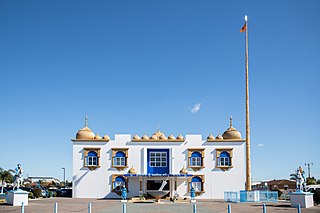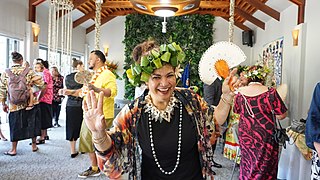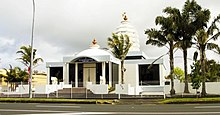
The demographics of New Zealand encompass the gender, ethnic, religious, geographic, and economic backgrounds of the 5.2 million people living in New Zealand. New Zealanders predominantly live in urban areas on the North Island. The five largest cities are Auckland, Wellington, Christchurch, Hamilton, and Tauranga. Few New Zealanders live on New Zealand's smaller islands. Waiheke Island is easily the most populated smaller island with 9,420 residents, while Great Barrier Island, the Chatham and Pitt Islands, and Stewart Island each have populations below 1,000. New Zealand is part of a realm and most people born in the realm's external territories of Tokelau, the Ross Dependency, the Cook Islands and Niue are entitled to New Zealand passports.

Gisborne is a city in northeastern New Zealand and the largest settlement in the Gisborne District. It has a population of 38,200. Gisborne District Council has its headquarters in the central city.

The Northland Region is the northernmost of New Zealand's 16 local government regions. New Zealanders sometimes refer to it as the Winterless North because of its mild climate all throughout the year. The main population centre is the city of Whangārei, and the largest town is Kerikeri. At the 2018 New Zealand census, Northland recorded a population growth spurt of 18.1% since the previous 2013 census, placing it as the fastest growing region in New Zealand, ahead of other strong growth regions such as the Bay of Plenty Region and Waikato.

Papatoetoe is a suburb in Auckland, New Zealand. It is the largest suburb in Auckland by population and is located to the northwest of Manukau Central, and 18 kilometres southeast of Auckland CBD.

South Auckland ) is one of the major geographical regions of Auckland, the largest city in New Zealand. The area is south of the Auckland isthmus, and on the eastern shores of the Manukau Harbour. The area has been populated by Tāmaki Māori since at least the 14th century, and has important archaeological sites, such as the Ōtuataua stonefield gardens at Ihumātao, and Māngere Mountain, a former pā site important to Waiohua tribes.

Paihia is the main tourist town in the Bay of Islands in the Northland Region of the North Island of New Zealand. It is 60 kilometres north of Whangārei, located close to the historic towns of Russell and Kerikeri. Missionary Henry Williams named the mission station Marsden's Vale. Paihia eventually became the accepted name of the settlement.
New Zealanders of European descent are mostly of British and Irish ancestry, with significantly smaller percentages of other European ancestries such as Germans, Poles, French, Dutch, Croats and other South Slavs, Greeks, and Scandinavians. European New Zealanders are also known by the Māori-language loanword Pākehā.

New Zealand is an island country in the southwestern Pacific Ocean. It consists of two main landmasses—the North Island and the South Island —and over 700 smaller islands. It is the sixth-largest island country by area and lies east of Australia across the Tasman Sea and south of the islands of New Caledonia, Fiji, and Tonga. The country's varied topography and sharp mountain peaks, including the Southern Alps, owe much to tectonic uplift and volcanic eruptions. New Zealand's capital city is Wellington, and its most populous city is Auckland.

Hinduism is the second largest religion in New Zealand. It is also one of the fastest-growing religions in New Zealand. According to the 2018 census, Hindus form 2.65% of the population of New Zealand. There are about 123,534 Hindus in New Zealand.
American New Zealanders are New Zealand citizens who are of American descent of American-born citizens from the United States. American New Zealanders constitute a small minority of New Zealand's population.

Māori are the indigenous Polynesian people of mainland New Zealand. Māori originated with settlers from East Polynesia, who arrived in New Zealand in several waves of canoe voyages between roughly 1320 and 1350. Over several centuries in isolation, these settlers developed their own distinctive culture, whose language, mythology, crafts, and performing arts evolved independently from those of other eastern Polynesian cultures. Some early Māori moved to the Chatham Islands, where their descendants became New Zealand's other indigenous Polynesian ethnic group, the Moriori.

New Zealander Sikhs number over 40,000 people and account for 0.9% of New Zealand's population as of 2018, forming the country's fastest-growing and fifth-largest religious group.
Asian New Zealanders are New Zealanders of Asian ancestry . At the 2023 census, 861,573 New Zealanders identifying as being part of the Asian ethnic group, making up 17.3% of New Zealand's population.
Tongan New Zealanders are Tongan immigrants in New Zealand, their descendants, and New Zealanders of Tongan ethnic descent. They constitute one of New Zealand's most sizeable ethnic minorities. In the 2013 census, 60,336 New Zealanders identified themselves as being of Tongan ethnicity with 22,413 stating that they were born in Tonga.
Māori Indians are an ethnic group in New Zealand of people with mixed Māori and Indian ancestry.

The culture of Auckland encompasses the city's artistic, culinary, literary, musical, political and social elements, and is well-known throughout the world. As New Zealand's largest city and one of the most important in the Southern Hemisphere, Auckland has a rich and dynamic cultural life and a long, multicultural history. Auckland's genesis as New Zealand's cultural heart began with the large-scale settlement of its fertile land by Ngāti Whātua and various Tainui hapū, before greater settlement by further iwi such as Ngāpuhi and the arrival of Pākehā. Auckland's culture derives further from its multicultural demographics, thanks to large-scale Indian, Colombian, Venezuelan, Arab, Cook Islands Māori, Tongan, Tokelauan, British, Irish, Fijian, Chinese, Niuean, Samoan, Filipino, Khmer, and intertribal Māori immigration, among others. From there, these communities established ethnic strongholds.

Pasifika New Zealanders are a pan-ethnic group of New Zealanders associated with, and descended from, the indigenous peoples of the Pacific Islands outside of New Zealand itself. They form the fourth-largest ethnic grouping in the country, after European descendants, indigenous Māori, and Asian New Zealanders. Over 380,000 people identify as being of Pacific origin, representing 8% of the country's population, with the majority residing in Auckland.
Punjabi New Zealanders are New Zealanders who are of Punjabi descent. Their ancestry originates wholly or partially in the Punjab region of South Asia, constituting a subgroup of Indian New Zealanders and Pakistani New Zealanders.















